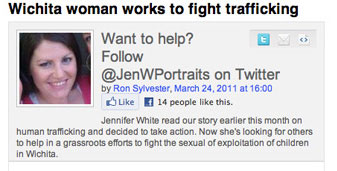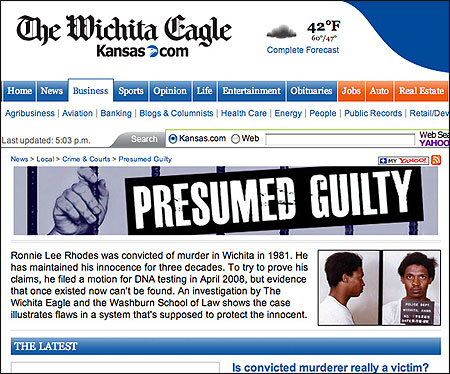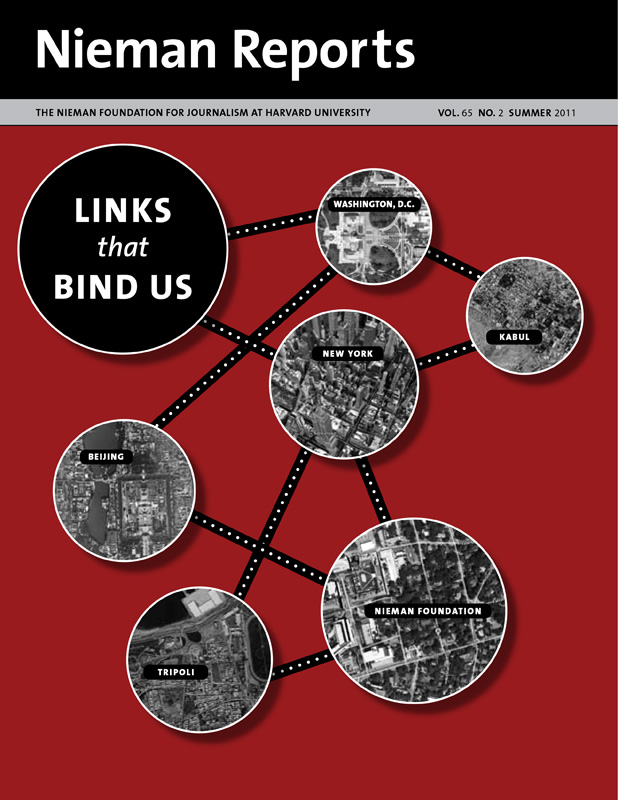
Two days after my story detailing the selling of teenage girls for sex in our city was published in The Wichita (Kansas) Eagle, this tweet arrived:
@JenWPortraits: Finally read @rsylvester's child traffic [sic] story. Sickening. Heartbreaking. How do we fix this?
Jennifer White, a suburban mom and photographer, sent it and in doing so kicked off a community project that raised truckloads of food and clothing and dozens of new volunteers to aid vulnerable teens living on our streets. At each donation drive or volunteer meeting, someone mentioned being moved to act by White's public sharing of her reaction to my story. Weeks after subscribers had recycled the newspaper, White was still crediting this story as an inspiration.
When I started using Twitter to cover trials three years ago, I had no idea of the power that social networking would have on my reporting.
"I just want to see how this works," I told Judge Ben Burgess, who gave me permission to tweet from his courtroom. My live trial coverage began, one 140-character message at a time, with the case of Ted Burnett in the murder-for-hire of Chelsea Brooks, a pregnant 14-year-old. Her 19-year-old boyfriend, Elgin Ray Robinson, Jr., apparently thought giving Burnett money and drugs to strangle Brooks would prevent her parents from pursuing a case of statutory rape. Instead, both men are serving sentences of life imprisonment without parole.
My tweets from the courtroom included more detail and dimensions of coverage—a sort of running color commentary from the trial—than a daily newspaper account ever could:
@rsylvester: One juror forgot to turn off his cell phone. Ring tone: "Carry on My Wayward Son," by Kansas (1976).
At the end of the first day, I began receiving e-mails and tweets from people who liked being able to follow the trial and a story that had horrified our city. They learned how detectives unraveled the crime while I discovered the power and connectedness of instant feedback. Often I refer to Twitter and Facebook as the digital public square or the community water cooler—the place where people gather to discuss the latest news and gossip. These social media tools have also become the circulation department of the modern newsroom.
U.S. District Court Judge J. Thomas Marten got it. The following spring the tech-savvy jurist allowed me to tweet a trial about Wichita street gang activity from a courthouse that had previously forbidden reporters to carry cell phones or computers. Followers stayed with me for six weeks, tweeting questions and comments. One of their favorites: an annual gang barbecue, held by the Crips and referenced by its nickname from the witness stand. "Cripnic! OMG Cripnic!" came one response.
Those who follow my tweets and Facebook postings appreciate having a virtual seat at the courthouse and insights about the inner workings of the justice system. A follower said she learned "it's not like 'CSI.' "

Risks and Rewards
This year I'm engaging with social media as I work on larger investigative projects. Trials have their own narrative, conducive to strings of tweets. Investigative stories unfold over time with gigabytes of information that may not have context for weeks or months.
A recent story I did followed Ronnie Rhodes, who had spent 30 years in prison after being convicted of murder. But a class of students at Washburn University's School of Law in Topeka, Kansas suspected he was innocent. As reporting about his case got under way, we decided to use my blog, "What the Judge Ate for Breakfast." It was risky to reveal parts of the story as it unfolded because in 30 years in this business I have seen projects hit dead ends. To publish incrementally might mean that the story would fizzle in public. Knowing this added tension for me, even if those in the social media community might not have appreciated this aspect of reporting the story in this way.
It was a colleague who convinced me that the reporting process would turn out to be as interesting as the underlying story. "There's a reason Superman was a newspaper reporter. Because it's a cool job, and people are interested, even if you're not Superman," said Katie Lohrenz, The Wichita Eagle's newsroom programmer and my 27-year-old online journalism mentor. At a time when many news organizations jealously guard their information, online editors John Boogert and Tom Shine realized that could change. Blogging this story meant we owned it.
The law class at Washburn first discovered problems with Rhodes's 1981 murder conviction after analyzing court transcripts, legal arguments, and evidence in the case. I wrote about Rhodes as I blogged about reporting. I filed short posts about my struggles to access records and find missing evidence.
My main rule: I wouldn't blog anything unless I could give it context. Sometimes I'd receive a piece of information that I wouldn't blog about for months because I didn't know what it would mean to the final story. Along the way, we posted rough cuts of videos and later we polished these for a multimedia presentation. We used comments on the blog to drive some of our reporting.
In the middle of all that, I met Rob Curley, head of online for the Las Vegas Sun, and a fellow Kansan. He told me how the Sun designed projects for online before giving them to print. We'd never done that, but now seemed a good time to try. So I began working with Eba Hamid, our Web producer, three months before we had set a print publication date for the Rhodes story. I deluged her with digital documents, videos and links and we finished our outline for our online presentation before the print side even saw the story budgets.
As the press ran, we stayed up half the night, adding the final touches, including links to outside resources. A priority was setting up multiple ways for community members to interact—with us and with each other. We assigned a Twitter hashtag, linked via Facebook, and set up a live chat with Rebecca Woodman, the law professor whose students launched the project. This expanded and improved the level of comments we usually see on a story; we received thoughtful responses and questions from those forums that led to follow-up stories. Links to our story traveled through networks of innocence projects around the country.
Social media forces me to stay involved in my community. Rather than simply dropping my stories off at the copy desk, I respond to reader comments and curate feeds from Facebook and Twitter. The story stays alive for days, or, as with the Rhodes and child trafficking stories, weeks and months after the initial run.
When Jennifer White expressed outrage about child trafficking, she sent me a DM (a direct, personal message) asking what she could do. I referred her to the Wichita Children's Home's Street Outreach program, which works to prevent sex trafficking of runaways. As White got involved, she chronicled her efforts on Twitter. I collected her tweets into a blog post. Our online content editor linked to it off our homepage. Within a day, White found her inbox stuffed with offers of help. Her efforts caught the attention of our CBS affiliate. Lori Buselt, our interactive content editor, linked to the TV story about White. In an online community, there is no competition.
During my career, I've seen important stories die within the 24-hour news cycle. But the online community, expanded by each individual's sharing within his or her social network, is giving my stories extended lives. Rhodes wrote that he's received support from prison staff members who have followed his story.
Social networking changes the relationship between reporters and their community. People stop being thought of as readers, viewers or an audience. They are friends. They follow you. They "like" you. I've found comments on Twitter and Facebook to be the most civil and insightful. On our website, people may comment anonymously. Sometimes, those can be hateful or inaccurate. I try to answer questions and politely correct inaccuracies. I've found that for those leaving comments, just knowing I'm paying attention can raise the level of conversation. Or, as White did, people become participants. Community members who once reacted to the stories we did now drive how we pursue the news.
A follow-up to the child sex trafficking story covered White's donation drive that produced the truckloads of items and $2,300 in cash for the Street Outreach program. But I didn't just write stories. I also retweeted posts by White and others in the community, linked to their blogs, and put updates on Facebook.
These tools have become as valuable for my reporting as my notebook. They lead sources to me, like the e-mail I received that raised a question so obvious I wondered why I hadn't thought of it myself: Why does the city of Wichita license escort services that seem to be involved in child trafficking?
The next day I sent a request for records to the city department responsible for issuing such licenses. That I didn't come up with this angle turns out not to matter. Let's just put it this way—a friend passed along this information in our new town square.
Ron Sylvester has covered courts for The Wichita Eagle and Kansas.com for the past 11 years. Learn more about him at rsylvester.com.



